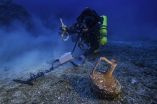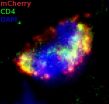(Press-News.org) Tempe, Ariz. (Oct. 9, 2014) - New Ebola research demonstrates that quick and forceful implementation of control interventions are necessary to control outbreaks and avoid far worse scenarios.
Researchers analyzed up-to-date epidemiological data of Ebola cases in Nigeria as of Oct. 1, 2014, in order to estimate the case fatality rate, proportion of health care workers infected, transmission progression and impact of control interventions on the size of the epidemic.
"Rapid and forceful control measures are necessary as is demonstrated by the Nigerian success story. This is critically important for countries in the West African region that are not yet affected by the Ebola epidemic, as well as for countries in other regions of the world that risk importation of the disease," said Arizona State University's Gerardo Chowell, senior author of the research and associate professor in the School of Human Evolution and Social Change in the College of Liberal Arts and Sciences.
The largest Ebola outbreak to date is ongoing in West Africa with approximately 8,011 reported cases including more than 3,857 deaths as of Oct. 5. Twenty Ebola cases have been reported in Nigeria, with no new cases reported since September 5, 2014. All of the cases stem from a single traveler returning from Liberia in July.
For the paper, "Transmission dynamics and control of Ebola Virus Disease (EVD) outbreak in Nigeria, July-September, 2014," published today in Eurosurveillance, researchers used epidemic modeling to project the size of the outbreak in Nigeria if control interventions had been implemented during various time periods after the initial case and estimated how many cases had thus been prevented by early initiation of interventions.
Control measures enacted in Nigeria included all people showing Ebola symptoms being held in an isolation ward if they had contact with the initial case. Once Ebola was confirmed through testing, people with Ebola were moved to a treatment center.
Asymptomatic individuals were separated from those showing symptoms and those who tested negative without symptoms were discharged. People who tested negative, but showed symptoms - fever, vomiting, sore throat and diarrhea - were observed and discharged after 21 days if they were free of symptoms, while being kept apart from people who tested positive for the disease.
"The swift control of the outbreak in Nigeria was likely facilitated by early detection of the initial case in combination with intense tracing efforts of all subsequent contacts that the person had after developing Ebola," said Folorunso Oludayo Fasina, a senior scientist and lead author of the study at the University of Pretoria, South Africa. "By contrast, the initial outbreak in Guinea remained undetected for several weeks, facilitating the spread of the virus to Sierra Leone and Liberia where the inability to track and contain infectious individuals compounded the situation and resulted in an uncontrolled epidemic."
Ebola transmission is dramatically influenced by how rapidly control measures are put in place, as researchers found that the projected effect of control interventions in Nigeria ranged from 15-106 cases when interventions are put in place on day 3; 20-178 cases when implemented on day 10; 23-282 cases on day 20; 60-666 cases on day 30; 39-1599 cases on day 40; and 93-2771 on day 50.
"There is brief window of time when a rapid and forceful intervention in terms of relentless contact tracing and isolation pays off handsomely and the transmission is effectively halted and the outbreak dies out," said co-author Professor Lone Simonsen, of the Milken Institute School of Public Health at the George Washington University in Washington D.C.
The person who was initially infected generated 12 secondary cases, in the first generation of the disease; 5 secondary cases were generated from those 12 in the second generation; and 2 secondary cases in the third generation, leading to a rough empirical estimate of the reproduction number according to disease generation declining from 12 during the first generation, to approximately 0.4 during the second and third disease generations. Recent estimates of the reproduction number for the ongoing Ebola epidemic in Sierra Leone and Liberia range between 1.5 and 2 (two new cases for each single case), indicating that the outbreak is yet to be brought under control.
"The effectiveness of the Nigerian response is illustrated by a dramatic decrease in the number of secondary cases over time. Overall, this is a great success story for Nigeria, which sets a hopeful example for other countries, including the U.S., which face risk of importation from high Ebola transmission areas," said Dr. Cécile Viboud, a National Institutes of Health scientist with the Fogarty International Center.
INFORMATION:
Authors of the new research are Chowell, Arizona State University; Fasina, University of Pretoria, South Africa; Aminu Shittu, Usmanu Danfodiyo University, Sokoto, Nigeria; David Lazarus, National Veterinary Research Institute, Plateau State, Nigeria; Oyewale Tomori, Nigerian Academy of Science, University of Lagos Campus, Lagos, Nigeria; Simonsen, George Washington University, Washington, D. C.; and Viboud, National Institutes of Health, Bethesda, Maryland.
Contacts:
Gerardo Chowell-Puente Chowell@asu.edu
Julie Newberg
Arizona State University
Media Relations
Julie.newberg@asu.edu
(480) 727-3116
A Greek and international team of divers and archaeologists has retrieved stunning new finds from an ancient Greek ship that sank more than 2,000 years ago off the remote island of Antikythera. The rescued antiquities include tableware, ship components, and a giant bronze spear that would have belonged to a life-sized warrior statue.
The Antikythera wreck was first discovered in 1900 by sponge divers who were blown off course by a storm. They subsequently recovered a spectacular haul of ancient treasure including bronze and marble statues, jewellery, furniture, luxury ...
WEST LAFAYETTE, Ind. – A new technique makes it possible to quickly detect the presence of drugs or to monitor certain medical conditions using only a single drop of blood or urine, representing a potential tool for clinicians and law enforcement.
The technique works by extracting minute quantities of target molecules contained in specimens of blood, urine or other biological fluids, and then testing the sample with a mass spectrometer.
Testing carried out with the technology takes minutes, whereas conventional laboratory methods take hours or days to yield results ...
SAN FRANCISCO -- The information that interprets the genetic code in a new embryo differs depending on whether it comes from the father or mother, researchers at San Francisco State University have found.
The research, detailed in an article published today in the journal PLOS Genetics, sheds light on the multilayered process of how a sperm and egg pass along information needed for successful reproduction. Though one layer is the DNA code that is transferred, the new study identifies information not encoded by DNA, a so-called "epigenetic" layer of information that helps ...
Most women are infected with HIV through vaginal intercourse, and without effective vaccines or microbicides, women who cannot negotiate condom use by their partners remain vulnerable. How exactly the virus establishes infection in the female reproductive tract (FRT) remains poorly understood. A study published on October 9th in PLOS Pathogens reports surprising results from a study of HIV transmission in the FRT of rhesus macaques.
Most studies of HIV transmission after vaginal exposure to date have been done in rhesus macaques and focused on the cervix, the lower part ...
VIDEO:
This video explains research done to understand the motion used by sidewinder snakes to climb sandy slopes and to apply that motion to a snake-like robot. Researchers from Georgia Tech,...
Click here for more information.
The amazing ability of sidewinder snakes to quickly climb sandy slopes was once something biologists only vaguely understood and roboticists only dreamed of replicating. By studying the snakes in a unique bed of inclined sand and using a snake-like robot ...
CANCER RESEARCH UK scientists have discovered that lung cancers can lie dormant for over 20 years before suddenly turning into an aggressive form of the disease, according to a study published in Science* today (Thursday).
The team studied lung cancers from seven patients – including smokers, ex-smokers and never smokers. They found that after the first genetic mistakes that cause the cancer, it can exist undetected for many years until new, additional, faults trigger rapid growth of the disease.
During this expansion there is a surge of different genetic faults ...
When young mice with the rodent equivalent of a rare autism spectrum disorder (ASD), called Rett syndrome, were fed a diet supplemented with the synthetic oil triheptanoin, they lived longer than mice on regular diets. Importantly, their physical and behavioral symptoms were also less severe after being on the diet, according to results of new research from The Johns Hopkins University.
Researchers involved in the study think that triheptanoin improved the functioning of mitochondria, energy factories common to all cells. Since mitochondrial defects are seen in other ...
During their approximately 100-day lifespan in the bloodstream, red blood cells lose membrane surface area, volume, and hemoglobin content. A study publishing this week in PLOS Computational Biology finds that of these three changes, only the observed surface-area loss can be explained by RBCs shedding small hemoglobin-containing vesicles budding off their cells' membrane.
Red blood cell concentration, mean volume, and hemoglobin content are routinely measured in the complete blood count, a fundamental clinical test essential to the screening, diagnosis, and management ...
As birth rates decline in countries that include parts of Europe and East Asia, threatening the economic slowdown associated with aging populations, a global study from the University of California, Berkeley, and the East-West Center in Hawaii suggests that in much of the world, it actually pays to have fewer children. The results challenge previous assumptions about population growth.
Researchers in 40 countries correlated birth rates with economic data and concluded that a moderately low birth rate – a little below two children per woman – can actually ...
A team of scientists including a University of Colorado Boulder professor used NASA's Hubble Space Telescope to make the most detailed global map yet of the glow from a giant, oddball planet orbiting another star, an object twice as massive as Jupiter and hot enough to melt steel.
The Hubble observations show that the planet, called WASP-43b, is no place to call home. It's a world of extremes, where winds howl at the speed of sound from a 3,000-degree-Fahrenheit dayside to a pitch-black nightside when temperatures plunge to a relatively cool 1,000 degrees Fahrenheit, ...




